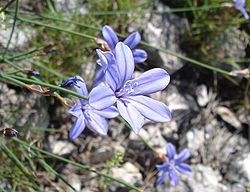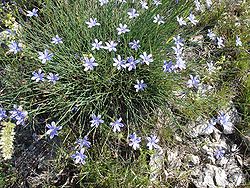- Aphyllanthes
-
Aphyllanthe de Montpellier
Aphyllanthe de Montpellier

Fleur de Aphyllanthes monspeliensis Classification classique Règne Plantae Sous-règne Tracheobionta Division Magnoliophyta Classe Liliopsida Sous-classe Liliidae Ordre Liliales Famille Liliaceae Genre Aphyllanthes
L., 1753Nom binominal Aphyllanthes monspeliensis
L., 1753Classification phylogénétique Ordre Asparagales Famille Asparagaceae 
Touffe d'Aphyllanthe de Montpellier

D'autres documents multimédia
sont disponibles sur CommonsParcourez la biologie sur Wikipédia : L'aphyllanthe de Montpellier (Aphyllanthes monspeliensis), ou œillet bleu de Montpellier est une espèce de plante. Elle appartient à la famille des Liliaceae selon la classification classique, ou à celle des Asparagaceae (optionnellement celle des Aphyllanthaceae) selon la classification phylogénétique APG II. Cette espèce est la seule actuellement acceptée du genre Aphyllanthes.
C'est l'une des plantes les plus caractéristiques des garrigues de la Méditerranée occidentale, où elle fleurit abondamment au printemps, formant des touffes rappelant les joncs. Les fleurs sont bleues, très rarement blanches.
Son nom signifie en grec « fleur sans feuilles ». Les feuilles sont en effet réduites à des gaines membraneuses à la base des tiges. Elle est appelée « jonça » ou « junça » en catalan et « bragalon » (prononcer « bragalou ») en occitan.
Sommaire
Synonymes
- Aphyllanthes juncea Salisb.
- Aphyllanthes cantabrica Bubani
Liens externes
Aphyllanthes
- Référence Catalogue of Life : Aphyllanthes (en)
- Référence Tela Botanica (France métro) : Aphyllanthes (fr)
- Référence NCBI : Aphyllanthes (en)
- Référence GRIN : genre Aphyllanthes L. (en)
Aphyllanthes monspeliensis
- Référence Catalogue of Life : Aphyllanthes monspeliensis (en)
- Référence Tela Botanica (France métro) : Aphyllanthes monspeliensis L., 1753 (fr)
- Référence NCBI : Aphyllanthes monspeliensis (en)
- Référence GRIN : espèce Aphyllanthes monspeliensis L. (en)
- Portail de la botanique
Catégories : Flore (nom vernaculaire) | Liliaceae | Asparagaceae
Wikimedia Foundation. 2010.
